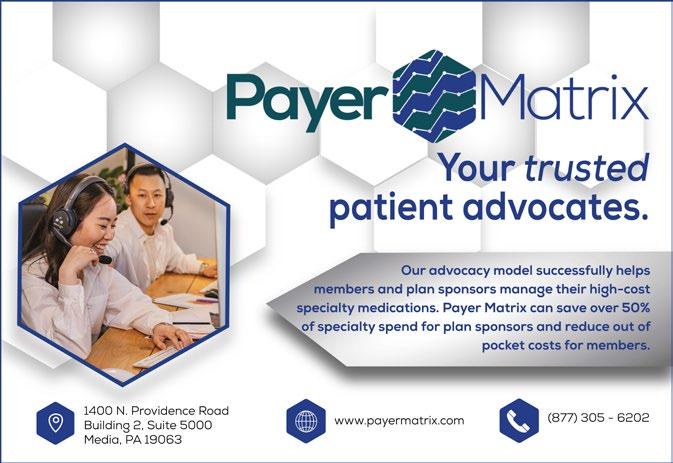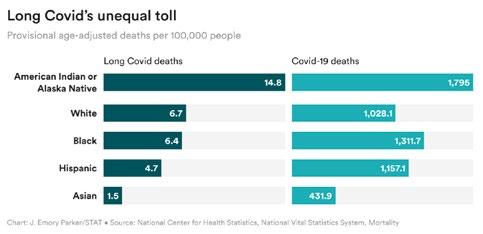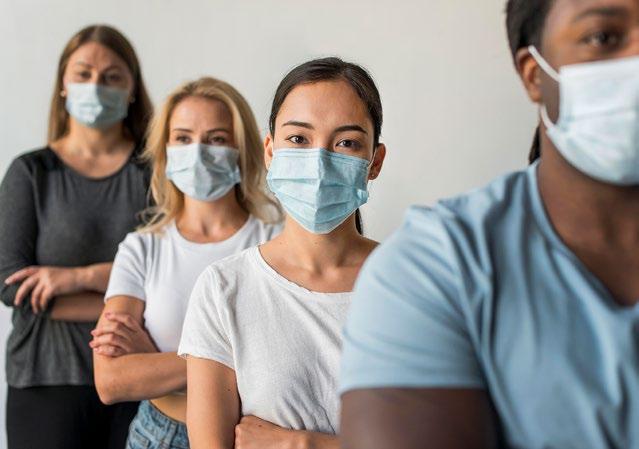
12 minute read
Long COVID is Real: New Chronic Condition Impacts Self-insured Community
Written By Laura Caravello
Justwhen everyone was starting to relax about the impact of COVID-19 on the workplace, it appears that it’s a long way from over.
Long COVID is a chronic illness that results from a Covid-19 infection and there are hundreds of potential residual symptoms or medical complications which can be debilitating for many people.
The Centers for Disease Control and Prevention (CDC) reports that millions of people suffer from Long COVID and David Cutler, an economist at Harvard University who projected the $3.7 trillion economic cost of Long-COVID estimates the individual medical costs of the disease to be about $9K+ a year, on average.
This does not include key treatment regimens for hospitalization as well as the indirect costs of workforce absence and potential patient disability.
Paul Fallisi, FSA, MAA, president, Windsor Strategy Partners, a leading actuarial firm, advises, "LongCovid is basically a new chronic condition requiring ongoing medical attention like high blood pressure, diabetes and obesity. It will affect claims morbidity for the foreseeable future! Fingers crossed that future variants of Covid-19 are mild – but extreme variants are a complete morbidity wild card.”
He points out that from 2020 through 2021, COVID-19 claims were offset by fewer doctor visits. Emergency Room visits, elective surgeries and dancer screenings, noting, “But going forward, 2023 total claims will be impacted by COVID-19 and Long COVID claims not offset by fewer physician office visits. Additionally, medical inflation will be higher due to higher general inflation and the addition of Long COVID claims and cancer claims will be higher due to delayed screenings and treatments. Unfortunately, cancer claims will be more expensive due to later than normal detection.”
Most Common Symptoms of Long COVID
• Coughing
• Ongoing, sometimes debilitating, fatigue
• Body aches
• Joint pain
• Shortness of breath
• Loss of taste and smell — even if this did not occur during the height of their illness
• Difficulty sleeping
• Headaches
• Brain fog: patients report being unusually forgetful, confused or unable to concentrate even enough to watch TV.
Source: UC Davis Health
Long COVID poses a significant business concern with broader workforce implications. It continues to alter the employment landscape, with the American Medical Association (AMA) estimating that 10-30% of the 81 million people diagnosed with COVID will develop long COVID, for months or years to come.
Fallisi reports that 13.3% of people that have had COVID-19 experience some of these symptoms one month after infection, 2.5% of these people experience some of these symptoms three months after infection and 30% of the people that were hospitalized for COVID-19 experienced some form of Long COVID six months after infection.



It should be noted that Post-COVID conditions are found more often in people who had severe COVID-19 illness, but anyone who has been infected with the virus that causes COVID-19 can experience post-COVID conditions, even people who had mild illness or no symptoms from COVID-19.
While most people with post-COVID conditions have evidence of infection or COVID-19 illness, in some cases, a person with postCOVID conditions may not have tested positive for the virus or known they were infected.
Given these statistics, astute employers need to understand their social and legal obligations to their employees. Failure to do so can be costly to employers directly from discrimination lawsuits, workplace injuries or other liability for other accidents caused by employees or product liability from substandard production.
There’s also the indirect costs to re-hire or retrain workers. Long COVID can result in continued disruptions and financial implications long into the future.
Jakki Lynch RN, CCM, CMAS CCFA, director cost containment, Sequoia Reinsurance Services says,
She explains that some patients, especially those who had severe COVID-19, have persistent heart, kidney, liver, and nervous system issues and even permanent damage to multiple organs requiring ongoing costly health treatment interventions.
Lynch cites these important studies:
A study published in 2020 in the journal JAMA Cardiology found 60% of people who had COVID-19 had ongoing signs of heart inflammation.
According to C. John Sperati, MD, a kidney specialist at Johns Hopkins Medicine in Baltimore, nearly a third of patients hospitalized for COVID-19 experienced kidney damage that may become chronic; some may need dialysis or a transplant.
According to United Network for Organ Sharing, the private, nonprofit organization that manages the U.S. organ transplantation system, total US transplant volume is trending upward among the working age group during the pandemic (despite a temporary dip in transplants early in 2020) compared to pre-pandemic volume.
Total costs for organ transplant are also increasing for solid organ transplants year-over-year with claims for a single transplant often exceeding $1 million, in particular lung and heart transplants per Milliman’s 2020 triennial report.
“Plan sponsors need affordability solutions to manage Long-COVID high risk expenses and maintain access to timely care,” she continues. “The key interventions to help manage this novel financial exposure include:
1) Promotion of best practices for prevention and early intervention strategies for treatment of COVID-19through proactive patient and provider communication.
2) Access to resources and proactive referrals to multidisciplinary specialist physician teams that focus on the treatment of Long-COVID.
3) Provider contract reimbursement analysis and targeted updates to address the unique risks and nuances of LongCOVID treatments.
4) Claim payment integrity reviews which ensure correct reimbursement and accurate payment of plan benefits.” right. www.bhspecialty.com/msl
Medical Stop Loss from Berkshire Hathaway Specialty Insurance comes with a professional claims team committed to doing the right thing for our customers – and doing it fast. Our customers know they will be reimbursed rapidly and accurately – with the certainty you would expect from our formidable balance sheet and trusted brand. That’s a policy you can rely on.
Here's some good advice from Jack Towarnicky, member, aequum LLC, an ERISA/Employee Benefits compliance and planning attorney, “Long COVID occurs when symptoms last over 30 days. The CDC estimates that 23 million Americans suffered long COVID, incurring hundreds of billions of medical expenses, and as stated above, the $9,000 per patient estimated expense doesn’t include lost wages or short and long-term disability benefit costs.”
Towarnicky points out that employee-patients also suffer financially:
• Where treatment stretches into 2023, most will have to satisfy another annual deductible,
• Sick leave, short and long-term disability benefits often don’t replace 100% of pre-disability wages, and
• Should long COVID continue for 12 weeks, some will lose employment and employer-sponsored coverage.
Impact On Workers Comp Claims
Employers should also be aware that as of July 2021, long COVID can be considered a disability under the Americans with Disabilities Act. To avoid lawsuits, it is advisable to educate and train managers since there may be no visible or outward signs of disability.
When an employee requests an accommodation related to this disability, management should determine if a reasonable accommodation could or should be made.
The long-term impact of the virus is complicating injured worker recoveries, impacting insurers and insureds’ ability to project claim costs. A growing number of patients -- “Long COVID” or “long haulers” --- will experience mild to moderate symptoms for a prolonged period of time.
With the relatively high concentration of COVID-19 workers compensation claims in the healthcare industry, this is regarded as an important development that merits monitoring. Amid this uncertainty, employers may be advised to know and prepare for these eventualities, as the uncertainty of long-term COVID-19 continues to be studied and evaluated.
Workers’ Comp experts at Liberty Mutual project:
1. COVID-19 claims are likely to be unique, not straightforward
With all the uncertainties of COVID-19, a common denominator seems to be that it can affect everyone differently. While some people return to normal fairly quickly, others experience a volatile recovery that includes relapses, and can take several weeks. Each COVID-19 occurrence may have distinct consequences – continuing to challenge riskplanning and complicating claimcost calculations over the long term. One study finds that the chance of full recovery from COVID-19 infection by day 50 is less than 20% for patients with prolonged symptoms.
2. COVID-19 claims may have long tails, with full impact unknown until later
Because some healthcare employers have scaled back operations at various points of the pandemic with workers logging fewer hours, working remotely, or being furloughed, they may see a modest decrease in the number of annual workers compensation claims, and, as noted above, the majority of COVID-19 claims have not been severe.
But concerns remain about the potential challenge that both employers and insurers may face with the long-tail nature of COVID-19 claims. According to the “2020 State of the Line Guide” by the National Council on Compensation Insurance (NCCI), there are several aspects that could easily extend active claims, including:
• Severity of illness will dictate costs – from lowcost medical care to treat mild symptoms, to hospital stays and/or extended rehabilitation for more serious cases;
• Delayed medical care and physical therapy for other non-acute conditions may contribute to injury creep – extending claim duration and putting upward pressure on costs; and
• Some COVID-19 claims may also involve a mental component and could require temporary or long-term treatment.
As a result, say the experts, premiums collected today must cover losses for years to come and significantly impact the cost of insurance.
3. COVID-19 experiences pose challenges to return-to-work norms and staffing
A key part of managing workers compensation costs is ensuring timely medical care in order to support return to work as quickly and safely as possible after recovery. But with delays and reductions in elective procedures, as well as patients delaying care and reducing their healthcare spending, the industry has seen broad furloughs and layoffs; workers on leave may not have jobs to which they can return. Fewer return-to-work and light-duty opportunities may be available, which could also boost claim duration.
In a recent survey by Milliman, more than 40% of hospital, clinic, home care, and long-term care organizations are encouraging employees who test positive for COVID-19 to apply for workers compensation if there is known occupational exposure. About 32% are providing other leave benefits such as quarantine pay and short-term housing.

Industry consultants also advise that Long COVID may create safety issues. Employers recognize a general duty to provide a safe working environment for their employees, as mandated by OSHA. But with potentially 24 million employees suffering from Long COVID symptoms, there may be an increased risk of workplace injuries and accidents.
This may be especially relevant in heavy labor industries or any industry with driving exposure where chronic fatigue, brain fog, and other long COVID symptoms present an intrinsically greater risk of employees sustaining an injury to themselves, co-workers or even the public.
LONG COVID CONTRIBUTES TO LIFE-CHANGING DISABILITY
Since there is no test to diagnose post-COVID conditions, and there is a wide variety of symptoms that could come from other health problems, it is difficult for healthcare providers to recognize postCOVID conditions.
Nevertheless, the AMA adopted a policy supporting “the development of an ICD-10 code or family of codes to recognize Long COVID (also known as post-acute sequelae SARS-CoV-2 infection or PASC) and other novel post-viral syndromes as a distinct diagnosis.”
Symptoms of Long Covid may go unrecognized as employees unknowingly suffer and find that they are experiencing issues such as chronic fatigue, brain fog, mental illness, chronic shortness of breath, migraines and other complex medical conditions that impact their ability to work.
It appears that Long COVID conditions align with the severity of infection. A new study in the Journal of Internal Medicine based on records for roughly 200,000 patients in Sweden describes who is diagnosed with a new condition and who had one before. Diagnoses tracked with illness severity, but there were other factors: females and those diagnosed with previous mental health disorders or asthma were more likely to have post Covid-19 conditions among nonhospitalized and hospitalized individuals.
Before acute infection, 53% of non-hospitalized, 48% of hospitalized, and 41% of ICU-treated individuals had one or more diagnoses that fit under the post-Covid condition umbrella, most often anxiety for nonhospitalized (16%) and hospitalized (12%) people and muscle pain (12%) for the ICU patients. The authors suggest “some of the disease burden could be wrongly attributed to Covid-19 or that Covid-19 accentuates pre-existing conditions.”
Avivit Ben-Aharon, founder and clinical director, Great Speech, a leading virtual speech therapy company, explains, “Brain fog and memory issues are among the wide range of concerns that plague individuals in their recovery of long COVID. These issues include cognitive impairment, and/or speech and language difficulties. Speech therapy provides an effective means to address such conditions-- helping patients who are affected by long COVID to confidently return to work, handle daily life and resume an active lifestyle.”
She says that virtual speech therapy provides the added benefits of allowing people to get help from the comfort of their homes or at work during their lunch break, “These benefits eliminate travel to an off-site brick-and-mortar facility and minimize opportunities for exposure of viruses and illnesses.”

EMPLOYERS DEBATE CONTINUED WORKPLACE COVID-19 TESTING
One quip that is circulating in the industry: “If you never get COVID-19, you will never suffer with Long COVID.”
To this point, NPR reports that the Centers for Disease Control and Prevention (CDC) warn two new omicron subvariants have become dominant in the United States, raising fears they could fuel yet another surge of COVID-19 infections. The subvariants — called BQ.1 and BQ.1.1 -- appear to be among the most proficient at evading immunity from vaccination and previous infection.
As a result, winter 2023 may cause workforces to experience higher rates of absenteeism and health problems as more employees call in sick to care for themselves and families. Many experts advise that routine COVID testing remains a vital way to limit the number of cases that hit workforces since even a mild SARS-CoV-2 infection can cause long COVID.
Analysts caution that people who are not vaccinated against COVID-19 and become infected might also be at higher risk of developing post-COVID conditions compared to people who were vaccinated and had breakthrough infections.
Source: STAT. December 14, 2022
Long Covid Now Appearing On Death Certificates
A new CDC report is disheartening: long COVID and other names for symptoms that persist after acute infection are appearing on death certificates in a small percentage of people who have died during the pandemic.
Harlan Krumholz, a Yale cardiologist who has been working with long COVID patients, says, "…the challenge is that the data they have provides only a floor of an estimate of the mortality burden of long Covid," including suicide.
Other experts say the CDC numbers are at best an undercount and at worst represent a “myopic” view of people living with Long COVID. The report also notes disparities in Long COVID deaths that reflect the pandemic overall. In addition to the death rate being highest among adults 85 and older and among men compared to women, non-Hispanic American Indian or Alaska Native people had a death rate that was more than twice as high as people from other racial or ethnic groups.

David Putrino, director of rehabilitation innovation at Mount Sinai Health System, expresses a troubling perspective that only emphasizes severe acute infection.
says Putrino, who started one of the first Long
COVID clinics in the U.S.
Scientists And Researchers Weigh In
This backdrop of “gloom and doom” has actually contributed to the creation of some very positive initiatives. The Long COVID Research Consortium was established as a scientific collaboration to rapidly and comprehensively study the condition, including scientists and clinicians from venerable institutions. including Harvard Medical School, University of California San Francisco, the J. Craig Venter Institute, Johns Hopkins, University of Pennsylvania, the Icahn School of Medicine at Mount Sinai, Cardiff University and Yale University.
They say it is no longer a mystery, with new research revealing key drivers of the condition, including evidence strongly suggesting that patients with Long COVID do not fully clear the SARS-CoV-2 virus. Instead, the virus may persist in tissue where it continues to provoke the immune system, driving a wide range of downstream consequences such as blood clotting, neuroinflammation and neuropathy.
One study from the Medical University of Innsbruck set out to look for molecular traces of virus in the gut, which is considered a favorite ‘hunting ground’ for researchers studying SARS-CoV-2. Of the 46 people who’d had COVID-19 months earlier, 21 of whom had at least one symptom of Long COVID.

The bottom line of the study published in May in Gastroenterology: all of those with Long COVID symptoms harbored viral RNA or, in some cases, viral proteins. Among those who’d recovered from acute COVID-19, 11 had traces of virus, too, whereas another 14 had no virus that researchers could find.
In the United States, microbiologist Amy Proal, a microbiologist with expertise in pathogen persistence who serves as president and chief scientific officer of the PolyBio Research Foundation. says she can’t stop thinking about a second leading Long Covid theory: that the coronavirus keeps hurting people by stubbornly enduring in the body, even after acute infection passes. She reports that studies have shown “the virus is capable of persistence in a wide range of body sites,” especially nerves and other tissues. Proal has had COVID-19 three times and asserts, “I consider Long COVID to be a massive emergency.”
Laura Carabello holds a degree in Journalism from the Newhouse School of Communications at Syracuse University, is a recognized expert in medical travel, and is a widely published writer on healthcare issues. She is a Principal at CPR Strategic Marketing Communications. www.cpronline.com
References: https://polybio.org/longcovid https://www.science.org/content/article/what-causes-long-covid-three-leadingtheories#:~:text=The%20bottom%20line%3A%20All%20of,study%20in%20May%20in%20 Gastroenterology.https://www.cnbc.com/2022/12/01/long-covid-costs-patients-an-average9000-a-year-in-medical-expenses.htmlhttps://fortune.com/2022/12/05/long-covid-millionsworkforce-170-billion-wages-employees-flu-season/ https://www.benefitspro.com/2022/05/23/what-employers-should-know-about-long-covid/ https://search.yahoo.com/search?p=long+covid+hurting+employers&fr=iphone&.tsrc=apple https://www.benefitnews.com/news/why-employers-need-to-reinstate-covid-testing-policies https://business.libertymutual.com/insights/3-impacts-of-long-term-covid-19-on-workerscomp-claims-healthcare-employers-need-to-know/ https://www.cdc.gov/coronavirus/2019-ncov/long-term-effects/index.html https://www.npr.org/sections/health-shots/2022/11/11/1136039817/new-omicron-subvariantsnow-dominant-in-the-u-s-raising-fears-of-a-winter-surge https://onlinelibrary.wiley.com/doi/10.1111/joim.13584?utm_source=STAT+Newsletters&utm_ campaign=b4c972cf41-MR_COPY_01&utm_medium=email&utm_term=0_8cab1d7961b4c972cf41-151821581 https://www.ama-assn.org/delivering-care/public-health/what-long-covid https://health.ucdavis.edu/news/headlines/covid-19-long-hauler-patients-search-for-answersand-help/2020/10 https://www.statnews.com/2022/12/14/long-covid-death-certificate-records/?utm_ source=STAT+Newsletters&utm_campaign=3524aa216a-MR_COPY_01&utm_ medium=email&utm_term=0_8cab1d7961-3524aa216a-151821581 https://www.bloomberg.com/news/articles/2022-12-14/long-covid-immune-effects-seenlinked-with-high-global-deaths








